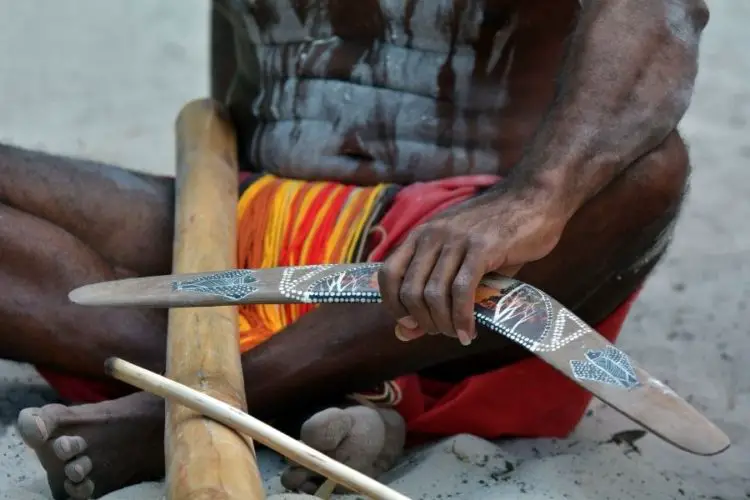The theory of survival is that the best ones live and the weaker ones die. To survive, we either need to have enough resources for everyone or we need to eliminate our competitors. Farming was not an option then, so men picked up weapons and started hunting to save themselves from starvation. They made their own weapons to hunt and fight. For both hunting and fighting, the boomerang was a great weapon.
Various artifacts that were used for different purposes have been found. Some of the artifacts could be used for several purposes as well. For example, a boomerang was used as a knife, as a digging tool, for making fire, and for producing music in conjunction with other tools.
The tools were different for different regions. It is unlikely that they were in touch with each other and could discuss their tools, so their ideas and tools were different. In some regions, people fought using shields and boomerangs, whereas in others they fought with clubs. Not all weapons were used for fighting; a majority of them were used for hunting.
Hielaman
A hielaman was a type of shield made from wood or bark. Aboriginal Australians used this shield to protect themselves in a battle. The work of this shield was similar to that used by later people during the war. At that time, only wooden weapons were introduced so these shields worked effectively.
Axe
Axes were not used during wars, but if the situation demanded it, they used it as a weapon. The primary work of an axe was cutting bark and roots for making canoes and rafts. Aboriginal axes had stone heads and wooden handles. Stone was attached to the handle using fired resin.
Woomera
The woomera was the spear-throwing device made by Australian Aboriginal people. The device served as an extension of the human arm, which allowed a spear to travel a greater distance with more speed. A woomera is 2–3 feet long and 3 inches wide. It is hollow from the inside and has a curved cross-section.
Some woomeras were painted and decorated to represent the ethnic group to which it belonged. According to researchers, woomera usage started 5,000 years ago, but the remains of Mungo Man that are older than 43,000 years shows the possibility that the woomera was used during that time too. The woomera is still used in some remote parts of Australia. It was mainly used by men.
Woomeras were not only used during wars; they were also used for other purposes. Woomeras that were shaped like bowls were used to carry water-soaked edibles. Other woomeras that had sharp edges, known as Tula adze, were used to cut wood and food. Different aboriginal groups had different-shaped woomeras.
Boomerang
Boomerangs were used for hunting, entertainment, and warfare. Boomerangs are made by carving wood with a slight curve. The curve makes hitting a target more accurate. Heavy boomerangs are more accurate. They can hit a target and bring down prey in one go. A light boomerang will only slow an animal or enemy; it will not wound them. The heavier the boomerang, the more useful it is. Most expert hunters are capable of hitting an animal from over 160 meters. Normally, small animals were hunted, but the red kangaroo was their favorite.
There is a difference between boomerangs that return and those that do not. A returning boomerang has two or more airfoil wings. If thrown correctly, this boomerang will come back. Returning boomerangs were mostly used for entertainment, whereas non-returning boomerangs were used for hunting. Non-returning boomerangs needed to go as straight as possible so that they could hit a target accurately.
We don’t know how returning boomerangs were invented, but researchers suggest that they originated from flattened sticks. Most boomerangs used by Australian Aboriginal people were non-returning. These were called kylies or throw sticks. These sticks were used to hunt birds. If thrown into a dense flock of birds, one kylie could kill multiple birds at the same time.
Spear
The spear is the best weapon. Flexible new shafts are heated for straightening and hardening before they’re stripped of their bulk and cut to the best lengths for each man. A wooden barb or sharp stone was attached to the tip of the spear.
Sorcery
You might think How can sorcery be a weapon? but during that time, it was a deadly weapon. Pointing bone and Kadiache shoes are well-known sorcery weapons. When a pointed bone is pointed at someone, it would make them grow sick, eventually leading to their death. Kadiache shoes, on the other hand, are probably a more practical weapon. It is a shoe that does not leave shoe prints behind. According to the beliefs, a Kadiache man could enter his enemy’s campsite while they were sleeping and kill them without a trace.
All weapons were used for both hunting and fighting. In both scenarios, you are trying to kill your prey. Some of these weapons can be traced back to the time period of Mungo Man. These weapons and artifacts allow researchers to understand the growth and development of ancient human beings. From these, we get clues as to how smart ancient peoples were.

